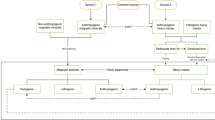Abstract
This review outlines the origin and environmental significance of magnetic minerals in lake sediments. Attention is drawn to situations where the patterns of mineral magnetic variation is a reflection of processes other than changing erosion rates and fire incidence. The use of mineral magnetic techniques in sediment source tracing, palaeoclimatic studies and the reconstruction of particulate pollution history is illustrated by means of case studies from Britain and N. America. The value of magnetic susceptibility as an on-site core logging technique is shown by reference to data from Lake Washington.
Similar content being viewed by others
References
Appleby, P. G. & Oldfield, F., 1983. The assessment of 210Pb Data from sites with varying sediment accumulation rates. Devel. Hydrobiol. 00: 000–000.
Bloemendal, J., Oldfield, F. & Thompson, R., 1979. Magnetic measurements used to assess sediment influx at Llyn Goddiondnon. Nature 280: 50–51.
Bloemendal, J., 1982. Unpublished Ph.D. Thesis, University of Liverpool 000 pp.
Dearing, J. A., 1979. The application of magnetic measurements to studies of particulate flux in lake-watershed ecosystems. Unpublished Ph.D. Thesis, University of Liverpool 000 pp.
Dearing, J. A., 1982. Core correlation and total sediment influx. In Berglund, B. (ed.). Paleohydrological changes in the temporate zone in the last 15 000 years. IGCP 158B. Lake and mire environments. Project guide Vol. 3. Lund., 1–23.
Dearing, J. A., 1983. Changing patterns of sediment accumulation in a small lake in Scania, S. Sweden. Devel. Hydrobiol. 00: 000–000.
Dearing, J. A., Elner, J. K. & Happey-Wood, C. M. (Mrs. D. G. E. Wood), 1981. Recent sediment flux and erosional processes in a Welsh upland lake catchment based on magnetic susceptibility measurements. Quat. Res. 16: 356–372.
Jones, B. F. & Bowser, C. J., 1978. The mineralogy and related chemistry of lake sediments. In: Lerman, A. (ed.). Lakes, Chemistry, Geology, Physics. Springer-Verlag, New York.: 179–236.
Le Borgne, E., 1955. Susceptibilité Magnetiqué anormale du sol superficiel. Ann. Geophys. 11: 399–419.
Longworth, G., Becker, L. W., Thompson, R., Oldfield, R., Dearing, J.A. & Rummery, T. A., 1979. Mössbauer effect and magnetic studies of secondary iron oxides in soils. J. Soil Sci. 30: 93–110.
Mullins, C. E., 1977. Magnetic susceptibility of the soil and its significance in Soil Science: A Review. J. Soil Sci. 28: 223–246.
Oldfield, F., Dearing, J. A., Thompson, R. & Garrett-Jones, S. E., 1978a. Some magnetic properties of lake sediments and their possible links with erosion rates. Pol. Arch. Hydrobiol. 25: 321–331.
Oldfield, F., Thompson, R. & Barber, K. E., 1978b. Changing atmospheric fallout of magnetic particles recorded in recent ombrotrophic peat sections. Science 199: 679–680.
Oldfield, F., Rummery, T. A., Thompson, R. & Walling, D. E., 1979. Identifications of suspended sediment sources by means of magnetic measurements: some preliminary results. Wat. Resour. Res. 15: 211–218.
Oldfield, F., Appleby, P. G. & Thompson, R., 1980. Paleoecological studies of lakes in the Highlands of Papua New Guinea. The chronology of sedimentation. J. Ecol. 68: 457–478.
Oldfield, F., Tolonen, K. & Thompson, R., 1981. Magnetic measurements of particulate atmospheric pollution history in dated Finnish peat profiles. Ambio 10: 185–188.
Oldfield, F., Appleby, P. G. & O'Garra, A. T., in press. Evidence from lake sediments for recent erosion rates in the Highlands of Papua New Guinea.
Revitt, M., Bryan Ellis, J. & Oldfield, F., in press. Variations in heavy metals of stormwater suspended solids in a separate sewer system. In: Yen, B. C. (ed.). Urban Storm Drainage. Proc. 2nd int. Conf. Urban Storm Drainage.
Rummery, T. A., Bloemendal, J., Dearing, J., Oldfield, F. & Thompson, R., 1979. The persistence of fire-induced magnetic oxides in soils and lake sediments. Ann. Geophy. 35: 103–107.
Rummery, T. A., 1983. The use of magnetic measurements in interpreting the fire histories of lake drainage basins. Devel. Hydrobiol. 00: 000–000.
Thompson, T. A., 1983. Global Holocene magnetostratigraphy. Devel. Hydrobiol. 000: 000–000.
Thompson, R., Battarbee, R. W., O'Sullivan, P. E., Oldfield, F., 1975. Magnetic susceptibility of lake sediments. Limnol. Oceanogr. 20: 687–698.
Thompson, R. & Morton, D. J., 1979. Magnetic susceptibility and particle-size distribution in recent sediments of the Loch Lomond Drainage basin, Scotland. J. Sed. Pet. 49: 801–812.
Author information
Authors and Affiliations
Rights and permissions
About this article
Cite this article
Oldfield, F., Barnosky, C., Leopold, E.B. et al. Mineral magnetic studies of lake sediments. Hydrobiologia 103, 37–44 (1983). https://doi.org/10.1007/BF00028425
Issue Date:
DOI: https://doi.org/10.1007/BF00028425




